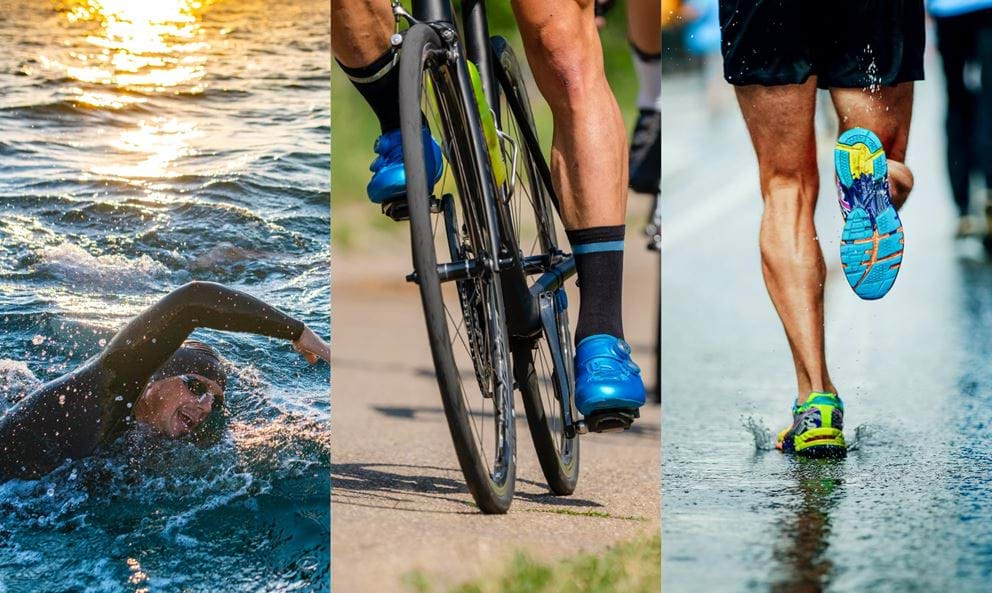Triathlon Training Plan

Why choose between cycling, running and swimming when you can do all three in a triathlon! This fun, yet challenging fitness event requires an understanding of three different disciplines, all of which require some level of training and preparation. Learn more about triathlons and how to train for them with this guide, or jump straight ahead for aa free triathlon training plan example*.
What is a triathlon?
A triathlon is a race or fitness event that incorporates swimming followed immediately by cycling and then running, with a speedy transitioning of kit and clothing between each segment. The first triathlon took place in 1974 in San Diego, California and has inspired more and more people to take part each year. Varying in length and location, some take part indoors, others outside, but each triathlon will always be broken down into the same three categories:
- Swimming - usually taking place in either a swimming pool or open water, the swim can be performed using either front crawl or breast stroke
- Cycling - often on roads outside, the bike route is usually signposted
- Running - again, usually outdoors along a determined route
How far is a triathlon?
Distances of a triathlon can vary depending on the type of triathlon being completed. What’s fantastic is, there are plenty of options depending on your experience and fitness levels - meaning you could start at the entryway Sprint Triathlon and work your way up to a full Ironman if it took your fancy! The most popular types of triathlon are:
- Sprint Triathlon - 750m swim, 20km bike, 5km run - this is ideal for first-time triathletes as an entry-way into triathlons and takes on average around 1 hour 30 minutes to complete
- Standard Olympic Triathlon - 1500m swim, 40km bike, 10km run - the typical distance featured in the Olympic games since the 2000 Sydney Olympics and takes an average of around 3 hours to complete
- Half Ironman Triathlon - 1.9km swim, 90km bike, 21km run - a challenging race that focuses on endurance and takes between 6 and 7 hours to complete
- Ironman Triathlon - 3.8km swim, 180km bike, 42km run - a long distance triathlon that really pushes its participants to the max, requiring extremely high levels of fitness and intensive training. This takes on average around 13 to 14 hours to complete.
How long does it take to train for a triathlon
How long you need to train for a triathlon depends very much on which one you’re planning to take part in. Training for a sprint triathlon as a beginner would be very different to training for a full Ironman - needless to say, the latter would definitely require a lot more time and extremely high fitness abilities.
Assuming this is your first sprint triathlon, around 12 weeks should be a good time frame, taking you from a beginner’s fitness levels through to being able to participate.
One thing you may want to do is to spend more time working on what you would consider you're least best at or have least confidence in, whether it's running, swimming or cycling to help prepare yourself for it. Seeking support and mentors from your local triathlon club is also a good place to build rapport too.
How do you plan a triathlon training schedule?
When training for a triathlon, unlike running-specific events like a 10K run or even a marathon, you need to split your workouts between three different types of exercise, making sure you’re building up your ability in all of them without over-exerting yourself. When creating a plan, work out how much time you’re willing or able to devote weekly to training - and then create your plan around this, ensuring you’re gradually increasing the amount of time you’re training for, or the distance you’re covering each week.
You’ll also need to consider preparing your body for the transitions between each type of activity, so practicing moving from cycling or swimming into running. Bike-to-run is considered the most challenging transition, so it’s definitely worth giving this plenty of focus in your training. This doesn’t just mean the physical transition from one activity to the other (for example, getting off your bike and starting running) but the shift your body needs to make when it adjusts from, say, half an hour of cycling, before needing to then run for half an hour.
How many hours a week should I train for a triathlon?
As with training for any major event, you’ll want to condition your body and endurance ability to help you complete your triathlon without risking injury. Take your time to ease through your plan and be aware of your starting fitness levels. If, for example, you’re only able to run for 15 minutes at a time, don’t let that stop you training, but make this your starting point and build up from there week by week. As a guideline, we’d recommend you plan in around five days of training every week, allowing two days for rest or gentle mobility and flexibility exercises like yoga. Of those five days, you can keep most to around 30 to 45 minutes of training, perhaps including a longer, endurance-focused training session at weekends.
What kit do you need for a triathlon?
A triathlon is no ordinary fitness event - there’s not just one, but three activities to prepare for. And, as anyone who’s even run a 10K will know, it can feel complicated enough having all the kit you need for a run, let alone three different sports in one! But there’s no need to feel overwhelmed, just think about the key items you’ll need for each section as a starting point - you’ll no doubt get an idea of these over your weeks of training. Then add on any nutritional requirements, as well as any items you’ll require just before or after the event.
You may have your own personal needs (perhaps depending on the length and intensity of the triathlon you’re training for, and even the weather on the day). You’ll need to consider hydration, sun protection, any energy gels required, a towel and a change of clothes for before and after the event. For the essential pieces of kit, however, this checklist will give an idea of the main items you’ll need.
- Swimsuit or wetsuit - so something to swim in! Depending on the temperature of the water, you should find a regular sports swimsuit will generally be fine, or a wetsuit for colder waters. Make sure you’ve trained in whatever you choose to wear, so it doesn’t spring any surprises or rub anywhere uncomfortable on the day.
- Bike - needless to say, this is a vital piece of kit for the cycling section of the triathlon. Again, during your training you’ll have learned the ideal set up for you, but make sure your bike is in good condition before race day, with pumped-up tires and well oiled wheels. You could also consider bringing a lock and bike pump in case they’re needed on the day.
- Cycle helmet – Don’t forget to wear a bike helmet with a kite mark (you don’t want to let this be the reason you’re not allowed to participate). Ensure it’s not damaged, comfortable, snug fit, and breathable enough to keep you cool.
- Triathlon kit - the clothing items you’ll be wearing for the cycling and running sections of the event. This will include some kind of running bottoms or shorts, a vest or t-shirt and a sports bra if needed. You’ll also want to include some sports socks. Some people purchase specific triathlon suits, which can be used for all elements of the event, but these can be expensive and are by no means essential. Just make sure you’ve practised in your outfit of choice and it’s cool and comfortable.
- Running shoes - a well fitting pair of running shoes is a key requirement. Make sure you’ve worn them in your training so they’re fitted well to your feet and won’t cause blisters throughout the race.
- Biking shoes (if required) - some people also bring biking-specific shoes that are clipped to help with the cycling section. If you’ve trained using these, then don’t forget to bring them on the day.
- Swimming goggles - a well fitting pair of goggles will help you on your swim. Make sure they’re prepped so they won’t steam up and ideally are designed to help protect from glare as you swim.
- Sunglasses - a sunny day essential, but also useful for protecting your eyes as you run and cycle. Make sure these fit snugly and won’t fall off during the race.
The free PureGym triathlon training plan
Our 12 week triathlon training plan is targeted at triathlon beginners, but with a basic level of fitness in place already. Ideally you’ll already be able to run for around 30 minutes, cycle for 30 minutes and swim at a gentle pace for around 30 minutes. If you’re still working up to that level, consider checking out our guide to training for a 5k - that will help you build up your fitness and endurance ready to start training for a triathlon.
In this plan, training sessions are split between:
- Strength training - a chance to work on your strength independently, either at the gym or at home. This will support your activity-focused training sessions by keeping your muscles strong and ensuring you’ll be less likely to suffer from injuries. We’ve written previously about why strength training is so important for runners. These sessions could include functional training, resistance work, bodyweight exercises or the use of the weights machines and equipment. Our Strength Training for Runners guide gives some ideas for exercises to try.
- Cycling - Tuesdays are for getting on your bike, working on your cycling form and endurance.
- Runs - Wednesday are run days, with a minimum of 30 minutes and maximum of 45 minutes running time.
- Swims - Fridays are time to hit the waters, whether you’re training in a pool or outside. You’ll practise swimming for between 30 and 45 minutes at a time.
- Combination training - well, it is a triathlon you’re training for! From week 4 onwards we recommend including a longer Saturday session that incorporates more than one type of activity, whether that’s cycling and running or swimming and running, to help you with your transitioning and continuing to build strength and endurance
- Rest days - don’t be tempted to skip your rest days, they’re vital in allowing your muscles time to recover and rejuvenate after a few days of training. Giving your body time to rest means you’ll feel refreshed ready for another training session, along with a host of other benefits - find out more with our rest days guide
As always, don’t forget to warm up before each training session (a brisk 5 - 10 minute walk, or some dynamic stretches can do the trick here) and to cool down afterwards (ideally some static stretches to promote blood flow, reduce stiffness and boost your flexibility).
Download a free PureGym triathlon training plan*Always check with your doctor before starting a new exercising regimen.


